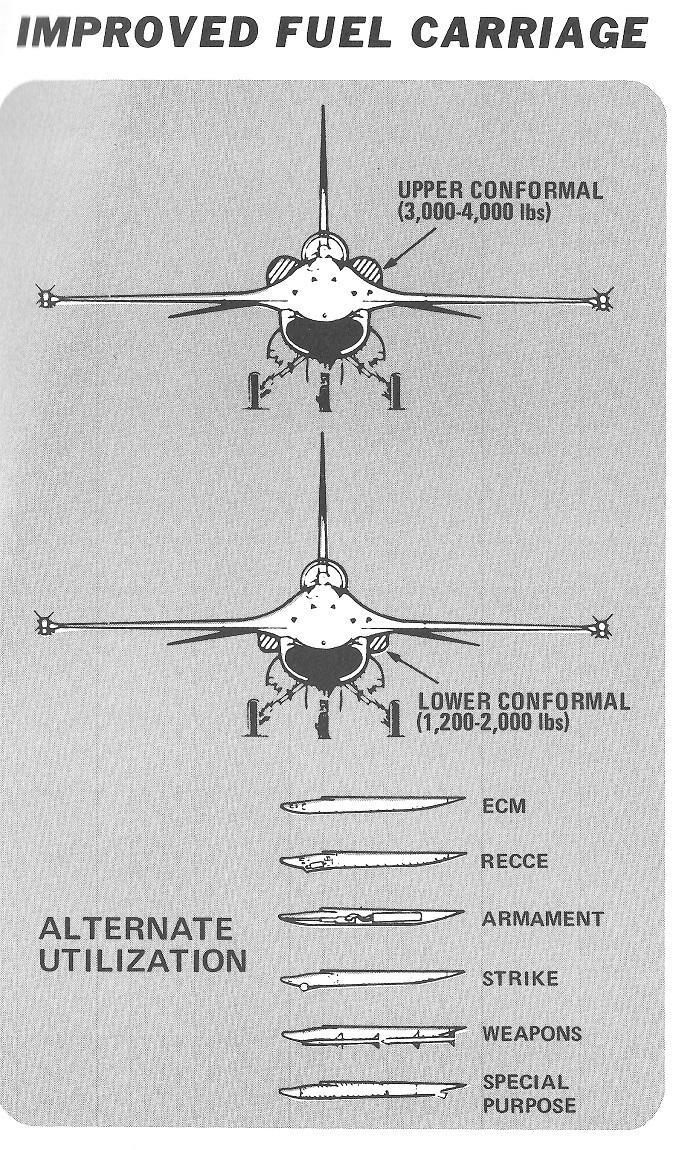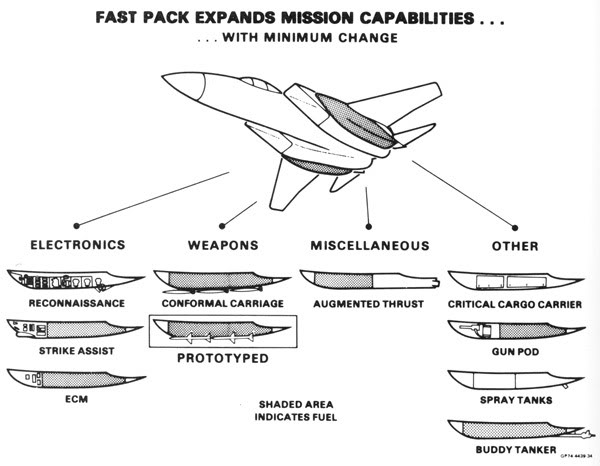1998년 NATO 문서의 새로운 전투기 패밀리 컨셉트
NATO Research and Technology Organisation이 1998년 12월에 낸 문서 "Aircraft Design Integration and Affordability"는 앞으로 애프터버너 켰을 때 추력 20톤, 켜지 않았을 때 추력 12톤에 자중 1톤의 엔진이 나온다고 가정하고 다음과 같이 7개의 파생형이 나오는 전투기를 상상했는데, 그 내용은 다음과 같습니다.
(i) 단발 STOVL, 조종석 뒤에 리프트 팬 설치 (지금의 F-35B)
(ii) 단발 CTOL 공격기, 리프트 팬을 빼고 그 자리에 연료나 내부 무장을 넣음
(iii) 단발 CTOL 전투기, 앞쪽뿐만 아니라 다른 쪽에서 봤을 때도 스텔스성 향상 (smoother structural joints나 RAM 더 발라서)
(iv) 복좌 후방차단기, 리프트 팬 자리에 WSO 자리를 만들고 payload-range 늘임
(v) 복좌 장거리요격기, 위의 항속거리 늘어난 복좌 후방차단기에 단발 CTOL 전투기의 향상된 스텔스 특성을 합침
(vi) 복좌 전자전기, 복좌 후방차단기에 전자전 장비를 채워 넣음 (Tornado ECR같은 존재)
(vii) SEAD 전용기, 위의 복좌 전자전기에 복좌 장거리요격기의 향상된 스텔스 특성을 합치고 대레이다 미사일로 무장시킴
마지막 4개 파생형은 복좌에 항속거리도 더 늘어나서 추력 20톤 엔진에서 파생된 추력 25톤 엔진을 쓰되 추가 연료와 무장은 "a range of conformal packs"로 해결하겠다는 생각이었습니다.
공격기와 전투기의 스텔스성 차이에 대해서는 "Limiting stealth to the frontal arc (±30° say), will allow a considerable economy, and may be acceptable for a strike aircraft, though less so for an air-superiority fighter."라고 공격기에는 전방 좌/우/위/아래 30도에 대해서만 RCS 줄이는 설계를 하면 상당한 비용 절약이 가능할 수 있다는 판단을 했습니다.
전투기의 경우 Eurofighter Typhoon처럼 BVR 미사일이 내 옆구리로 날아올 확률이 매우 낮다고 판단하면 꼬리날개를 하나만 두어도 되겠죠.
그리고 이 문서는 스텔스기의 안에 집어 넣을 무장의 크기를 줄이는데 드는 비용은 스텔스기 개발 비용의 작은 일부에 지나지 않는다며 무장의 크기를 줄이는데 돈 쓰는게 현명할 수도 있다고 주장했습니다.
1976년에 생각한 F-16의 conformal pack

====================
7.1. An Advanced 20-ton Thrust Engine
A new generation of combat aircraft which we term NGF (New Generation Fighter) could be designed around an advanced 20-ton thrust class (or two 10-ton tbmst class) engine(s), weighing little more than 1 ton, and no larger in overall dimensions, or cross-sectional area, than current fighter engines. The new engine would have a military (i.e. non-afterburning) thrust of at least 12 ton, allowing supersonic cruise, with a total fuel consumption comparable to current engines, due to a lower specific fuel consumption. It should be fitted with a two-axis thrust vectoring nozzle, for post-stall flight and control and stabilisation across the flight envelope, plus the option of vertically deflected thrust for STOVL. Together with these enhancements, part count, maintenance requirements, durability and cost should also improve, or at least not degrade. The attractions of a twin-engine solution remain, e.g. for carrier-borne operations, or use over water or in arctic regions, even if two engines may cost more than a single larger one.
The question of one versus two engines, like that of one versus two crew, is as old as tighter design, and involves a share of tradition and operational philosophy. The USN has traditionally required twin-engine fighters for most missions (F-4, F-14, F-18, and A-6), although it has operated single-engine types (F-8, A-4 and A-7) with comparable reliability. The RAF has had a consistent preference for twin engines (Meteor, Javelin, Lightning, Jaguar, Tornado, EF 2000), whereas the USAF has fielded simultaneously one (F-104, F-105, F-106) and twin-engine (F-101, F-4) fighters, of comparable or dissimilar (one engine F-16 or twin-engine F-15) capabilities. The French Armee de l'Air has favoured in the past twin-engine prototype fighters, but had to bow to the political choice of cheaper, more exportable single engine types (Mirage III, F1, 2000), until the advent of Rafale. Advances in engine technology and cost limits may favour the single engine solution, but they may not close the debate.
7.3. Modular Multi-Mission Airframe
Around this advanced engine would be built a modular airframe, able to perform nearly all seven of the fighter missions:
(i) a single-seat specialised STOVL variant, with a lift system in the fuselage behind the cockpit;
(ii) a single-seat CTOL variant for ground attack, using this space for increased internal fuel tankage or additional internal weapons bays;
(iii) a single-seat CTOL variant aimed at air superiority, with improved stealthiness, in aspects other than head-on, e.g. smoother structural joints and more radar absorbent material;
(iv) a two-seat interdiction variant, with the second crew member taking some of the space of the lift system, and other changes to increase payload-range over and above that of variant ii;
(v) a possible two-seat long-range interceptor, combining the extra crew member and range of variant iv with improved stealthiness of variant iii;
(vi) a specialised electronic support measures (ESM) variant, based on the two-seat interdiction variant, with a comprehensive avionics suite, allowing also surveillance and reconnaissance;
(vii) a specialised suppression of enemy air defence (SEAD) version, combining the two-seat avionics intensive variant vi, with improved stealthiness of variant v, and armament options from variant iv, with additional anti-radiation missile capability.
7.4. Low and High Family Mix
It is clear that the last four variants would need to be heavier and more capable aircraft. This could still be accommodated within the same family, by means of a number of optional changes:
- availability of a growth engine, with a thrust of around 25 ton, to power later variants, enabling a higher gross weight;
- development of a range of conformal packs, to increase fuel load or accommodate additional weapons, taking advantage of the higher gross weights, with little drag penalty;
- possible development of a variable-geometry wing, to increase range and endurance to values similar to those of the F-111.
7.7. Incorporation of Stealthy Features
Due to the high cost and lifetime penalties of extreme stealth, the cost target cannot be met without some restraint in this area too. First, the systems architecture and data links should exploit to the maximum extent mission planning and cooperation with other friendly forces to maximise situational awareness and increase survivability. Stealth features should be compatible with a large internal volume, for fuel and weapons; this could be a key driver in the selection of a configuration. Stealth might be degraded in the basic version by doing without very close tolerances and part fit. Limiting stealth to the frontal arc (±30° say), will allow a considerable economy, and may be acceptable for a strike aircraft, though less so for an air-superiority fighter. A fraction of the cost of stealth might be better spent in miniaturising air-to-air and air-to-surface weapons, to allow stealthy carriage of larger numbers in internal bays and conformal packs. The general perspective would be to exploit stealth as an enhancement of mission effectiveness and survivability, but not at an extremely high cost, or underestimating that the value of stealth may be reduced by improved sensors such as long wave and bi-static radars. Attention to other observables, like IR signature, noise, camouflage and contrails must complement radar stealth.

F135나 ADVENT 생각을 해보면 뭐 이미 얼추 달성은 했다고 봐도 되려나요? 리프팅팬 자리에 고에너지 빔 병기 달겠단 이야기 생각이 나네요.
마지막 컨포멀 팩 짤은 어디서 많이 봤다 생각했더니만 FAST pack 파크리...

이 글에 거의 다 나왔네요. KFX(`보라매사업'이자 이성찬님이 과거 지나친 표현이라고 지적했다가 화랑님과 언쟁까지 벌였던 `베이비랩터'-왜? 직역하면 이상해서?-이기도 한)
마치 베끼기라도 한 것처럼....
쌍발과 단발은 ROC의 문제가 아니라고 저도 생각합니다. 실로 운영 철학의 문제지요.
제가 보는 문제는 저겁니다. "가능하면 가변익을 개발한다....."
일단 ADD 쪽에선 다이야 형상이라고 밝히고는 있는데 지난 ADEX에서의 모형을 보면 처음부터 익형에 대한 고려없이 제작된 것 같고....몇번인가 가변익도 괜찮치 않느냐며 복선을 깔아두기는 하는데....
뭐가 좋을 지는 아직 잘 모르겠네요. ^^;



